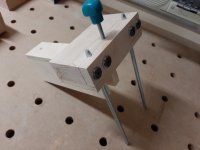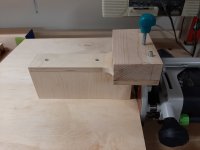Michael Kellough
Member
Crazyraceguy said:It takes some set-up to get it right. It is very easy because of the 1/10mm height adjustment screw. Once you are there, with a larger diameter cutter, I get perfect results. You can dial the follower wheel to hit right at the seam line and never dig into the ply veneer.
Though I don't really recommend it, you can also climb cut with it too. This will stop any kind of tear-out, but you have to be aware of how much you are removing and it has to be very little.
I sure wanted something like that earlier today when trying to set depth on a Makita cordless router with it’s crude rack and pinion system. Trying to set the cutter depth to match an existing chamfer was hit or miss.



